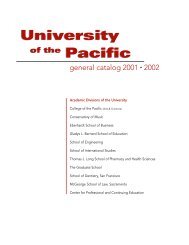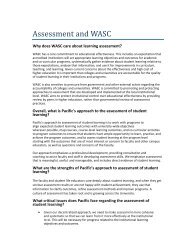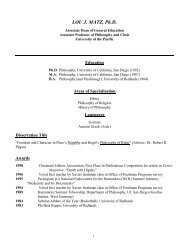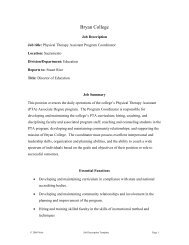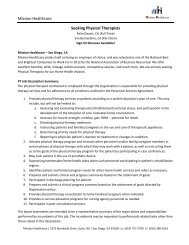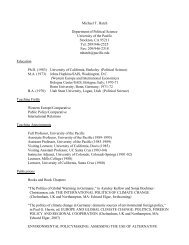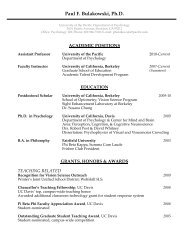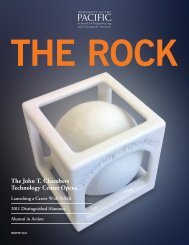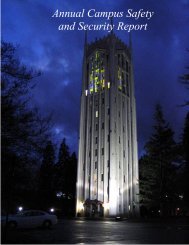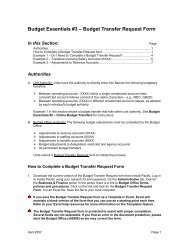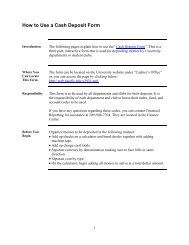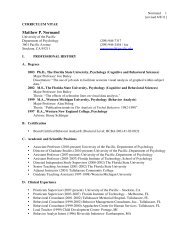purcc 2012 - University of the Pacific
purcc 2012 - University of the Pacific
purcc 2012 - University of the Pacific
Create successful ePaper yourself
Turn your PDF publications into a flip-book with our unique Google optimized e-Paper software.
Poster Session Abstracts<br />
Views on Current Events<br />
Amir Cruz-Khalili, Sadaf Sahibzada, Marissa<br />
Davis, Tabrisha Johnican<br />
Faculty Mentor: Gary Howells,<br />
Rocci Jackson (Graduate student)<br />
Previous research has examined implicit or<br />
indirect discrimination before and after events<br />
that have fostered <strong>the</strong> national fear <strong>of</strong> Islam<br />
(Sheridan, 2006). This study will explore<br />
Islamophobia, looking at opinions on current<br />
events throughout <strong>the</strong> world, with or without<br />
exposure to a historical source. It is presumed<br />
that with <strong>the</strong> presence <strong>of</strong> a biased historical video<br />
clip, participants will rank higher on an<br />
Islamophobia scale compared to those not<br />
exposed. Thirty participants will be recruited<br />
from a small, private <strong>University</strong> in Nor<strong>the</strong>rn<br />
California. Three conditions - <strong>the</strong> viewing <strong>of</strong> a<br />
historical clip, <strong>the</strong> viewing <strong>of</strong> a Muslim comedy,<br />
and <strong>the</strong> control group - will be run using a<br />
between-subjects ANOVA. The scores will be<br />
taken from a validated Islamophobia scale.<br />
Results <strong>of</strong> <strong>the</strong> study should reveal an association<br />
between <strong>the</strong> presence <strong>of</strong> a video clip and <strong>the</strong><br />
level <strong>of</strong> Islamophobia. Future studies should<br />
incorporate a larger sample size, a more diverse<br />
population, and an eclectic assortment <strong>of</strong> video<br />
clips and/or current events.<br />
War Attitudes Across Gender<br />
Alina Franco, Megan Rangel, Ginny<br />
Durakovich, Christina Thompson<br />
Faculty Mentor: Gary Howells,<br />
Rocci Jackson (Graduate student)<br />
The purpose <strong>of</strong> this study to evaluate gender<br />
differences in attitudes toward war and to<br />
determine whe<strong>the</strong>r exposure to positive or<br />
negative war information affects explicit attitude.<br />
Previous research has suggested that women are<br />
more willing to participate in peaceful<br />
encounters, have more consistent and positive<br />
attitudes towards conflict groups (Yablon, 2009).<br />
Therefore it is hypo<strong>the</strong>sized that women will<br />
hold more consistent and negative views toward<br />
war than men. Thirty participants (15 males, 15<br />
females) will be recruited from a small private<br />
university. Using a between-subjects design,<br />
participant’s attitudes toward war will be<br />
measured across two sessions using a 5-point<br />
Likert scale, 12- item survey from <strong>the</strong> Revised<br />
Attitudes Towards Violence Scale (2006) in<br />
combination with six student designed items. All<br />
participants will complete a pre-intervention<br />
survey before exposure to ei<strong>the</strong>r “pro war” or<br />
“pro peace” information. In <strong>the</strong> final session,<br />
participants will be given a second but similar<br />
survey to determine whe<strong>the</strong>r exposure to<br />
information regarding war elicited a change in<br />
attitude. Implications <strong>of</strong> this study may suggest<br />
gender differences in vulnerability to propaganda<br />
and could shed light on national military action<br />
over past years. Limitations include small<br />
sample size time constraints and experimenter<br />
presence may have influenced <strong>the</strong> responses <strong>of</strong><br />
participants. Future research could evaluate <strong>the</strong><br />
relationship between SES or ethnicity and<br />
attitudes toward war.<br />
Prosocial Behavior In Instances <strong>of</strong> Theft<br />
On College Campuses<br />
Tyler Glassford, Sean Kagan, Jonel Imutan,<br />
Nina Shenker<br />
Faculty Mentor: Gary Howells,<br />
Rocci Jackson (Graduate student)<br />
Prosocial behavior refers to <strong>the</strong> voluntary efforts<br />
one takes in order to benefit ano<strong>the</strong>r, even when<br />
<strong>the</strong>re appears to be no incentive or gain in doing<br />
so (Eisenberg, Fabes & Spinrad, 2007). Prosocial<br />
behavior can refer to acts as minimal as sharing<br />
and volunteering, or as significant as intervening<br />
in a violent crime. There may be many factors<br />
influencing one’s decision to be prosocial such<br />
as <strong>the</strong> timing and location <strong>of</strong> <strong>the</strong> instance, <strong>the</strong><br />
number <strong>of</strong> o<strong>the</strong>r bystanders, etc. Alternatively,<br />
<strong>the</strong> bystander effect refers to instances when<br />
individuals refrain from engaging in prosocial<br />
behaviors as a situation presents itself. The<br />
question <strong>the</strong>n becomes, how and when does one<br />
decide to engage in prosocial behavior? The<br />
present study will investigate prosocial behavior<br />
<strong>of</strong> college students on a small university campus<br />
in Nor<strong>the</strong>rn California. Confederates <strong>of</strong> <strong>the</strong><br />
study will leave <strong>the</strong>ir belongings unattended for<br />
ano<strong>the</strong>r confederate to attempt to steal those<br />
belongings in <strong>the</strong> presence <strong>of</strong> an unaffiliated<br />
bystander. Prosocial behavior will be evaluated<br />
in terms <strong>of</strong> <strong>the</strong> bystanders’ decision to intervene<br />
or not. It is hypo<strong>the</strong>sized that gender will<br />
influence one’s decision to engage in prosocial<br />
behavior.<br />
41



